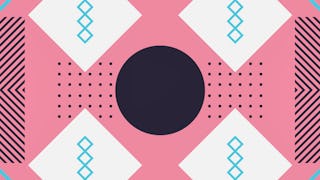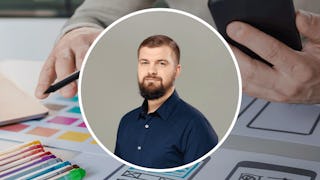Great design doesn’t come out of nowhere; it is born, nurtured, and grown--all through a systematic, learnable process. In this UX course, you will explore the process of taking a basic concept, grounded in user needs, and developing it into a design that will address those needs. In the course, you will gain hands-on experience with techniques such as sketching, scenario development, storyboarding, and wireframing that will help you transform your understanding of what your users need into a compelling user experience. You will then learn how to turn wireframes and interaction architecture into interactive prototypes that can be tested with prospective users and iteratively refined into a high quality design that that is ready for a hand-off to the development team for implementation.

Enjoy unlimited growth with a year of Coursera Plus for $199 (regularly $399). Save now.

UX Design: From Concept to Prototype
This course is part of User Experience Research and Design Specialization

Instructor: Predrag Klasnja
44,234 already enrolled
Included with
(300 reviews)
What you'll learn
Define and scope the design problem
Create user stories and storyboards to transform information about user needs into design concepts
Develop prototypes from elements of interactions and low-to-high fidelity mockups
Skills you'll gain
Details to know

Add to your LinkedIn profile
See how employees at top companies are mastering in-demand skills

Build your subject-matter expertise
- Learn new concepts from industry experts
- Gain a foundational understanding of a subject or tool
- Develop job-relevant skills with hands-on projects
- Earn a shareable career certificate

There are 6 modules in this course
In this module, you will be introduced to the nature of design, the design process, and methods of formative research. You are expected to spend 2 to 3 hours on this module’s workload. By the end of this module, you will understand the user experience design process and how to conduct formative research.
What's included
4 videos4 readings1 assignment1 discussion prompt
This module will cover one of the practical topics in this course --- ideation. You will brainstorm and sketch possible solutions to your design problem in this module’s assignment. You will also share your sketches with your fellow learners, hear their thoughts about your designs, and provide feedback on their work. By the end of this module, you will gain an understanding of various methods of ideation, as well as the structure developed by Haakon Faste and Eric Paulos for brainstorming.
What's included
3 videos1 reading1 assignment1 peer review1 discussion prompt
This module will introduce the other practical topics --- creation of early design representations like scenarios, personas, and storyboards that illuminate findings about user needs discovered through your formative research. By the end of this module, you will learn how designers move from formative research to a design solution, how the “Questions, Options, Criteria” framework can help us make design decisions, and gain hands-on experience in creating personas, scenarios, and storyboards.
What's included
4 videos1 reading1 assignment2 peer reviews1 discussion prompt
In this module, we will start with understanding the conceptual underpinnings of user interactions by introducing the basic building blocks of user interaction. In addition to lectures, quizzes and discussions, this module involves actual design work: planning out the kinds of information the system you are designing will need to take in, and the kinds of feedback it will need to provide to users. By the end of this module, you will be able to define the elements of user interaction and types of data input. You will also be able to design effective inputs and outputs to enable users to complete tasks successfully as well as conceptualize design problems by using the building blocks of user interaction.
What's included
4 videos1 reading1 assignment1 peer review1 discussion prompt
Module 5 will provide an overview of different forms of prototyping. Your design work for this module will be wireframing the main screens of your application. By the end of this module, you will be able to identify the characteristics and applications of low-fidelity and hi-fidelity prototypes and apply the most effective prototype for answering a particular design question. Also, you will learn how to test design concepts and functionality by utilizing wireframes and create low-fidelity and hi-fidelity prototypes to assess and improve your design.
What's included
4 videos1 assignment1 peer review1 discussion prompt
This module introduces some of the issues that designers need to think about when prototyping, such as defaults and mental models. You will create a functional low-fidelity prototype of your design. By the end of this module, you will understand the affordances and limitations of interface formats, learn to evaluate how the default features of a design impact the user experience, identify potential consequences of usage beyond a design’s intentions, and describe the gulfs of execution and evaluation.
What's included
5 videos4 readings1 assignment1 peer review1 discussion prompt
Earn a career certificate
Add this credential to your LinkedIn profile, resume, or CV. Share it on social media and in your performance review.
Instructor

Offered by
Explore more from Design and Product
 Status: Free Trial
Status: Free TrialCalifornia Institute of the Arts
 Status: Free Trial
Status: Free Trial Status: Free Trial
Status: Free Trial Status: Free Trial
Status: Free Trial
Why people choose Coursera for their career




Learner reviews
300 reviews
- 5 stars
81%
- 4 stars
15.33%
- 3 stars
2.33%
- 2 stars
0.66%
- 1 star
0.66%
Showing 3 of 300
Reviewed on Aug 9, 2020
Good introduction to prototyping. I recommend changing the paper prototype to a software-based version.
Reviewed on Nov 16, 2019
It was great experience learning step by step. Assignment are very practical. Thank you
Reviewed on May 28, 2024
Great course! But some information is not relevant anymore - I mean the Tools and technologies specified in the course.

Open new doors with Coursera Plus
Unlimited access to 10,000+ world-class courses, hands-on projects, and job-ready certificate programs - all included in your subscription
Advance your career with an online degree
Earn a degree from world-class universities - 100% online
Join over 3,400 global companies that choose Coursera for Business
Upskill your employees to excel in the digital economy
Frequently asked questions
To access the course materials, assignments and to earn a Certificate, you will need to purchase the Certificate experience when you enroll in a course. You can try a Free Trial instead, or apply for Financial Aid. The course may offer 'Full Course, No Certificate' instead. This option lets you see all course materials, submit required assessments, and get a final grade. This also means that you will not be able to purchase a Certificate experience.
When you enroll in the course, you get access to all of the courses in the Specialization, and you earn a certificate when you complete the work. Your electronic Certificate will be added to your Accomplishments page - from there, you can print your Certificate or add it to your LinkedIn profile.
Yes. In select learning programs, you can apply for financial aid or a scholarship if you can’t afford the enrollment fee. If fin aid or scholarship is available for your learning program selection, you’ll find a link to apply on the description page.
More questions
Financial aid available,
¹ Some assignments in this course are AI-graded. For these assignments, your data will be used in accordance with Coursera's Privacy Notice.

